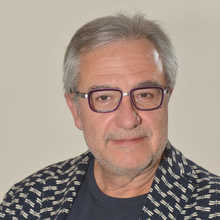Tell us about yourself: where you come from, what you teach at Ca' Foscari, what are your interests and research areas
My name is Giuseppe Barbieri and before coming to Ca' Foscari (in late 2003) I taught for a long time at the University of Udine. In the last few years, however, I have taught very little, to tell the truth, because I have been twice voted head of department, a position that does not leave much time for teaching. I teach Methods, Approaches and Tools for the History of Art, a course that matches my research interests quite closely: theories of art, methods of approach and strategies to experience works of art, also using modern technologies. Without denying consolidated knowledge, but rather updating it year after year. For some years now, I have dedicated a significant part of my efforts to Russian art, especially contemporary art.
Tell us about your academic path.
Unusual. At university (Padua) I studied History (modern, above all), not History of Art (which I studied later, on my own, by reading, studying, writing, watching and reviewing, as Adolfo Venturi would have said, visiting and discussing with mentors and colleagues). In short, destiny changed paths, perspectives, destinations. Then I took a PhD (with some trouble at the end) in History of Architecture (IUAV), followed by a series of public competitions, some lost and some won, luckily. For 16 years I have been a full professor of History of Modern Art: I will soon be done, even if the desire to research does not retire...
What are your professional references?
It would be better to say cultural and scientific references. They have been many, different, and many of them beyond a too rigid disciplinary horizon. I have had the good fortune to meet and be friends with writers (such as Luigi Meneghello or Tzvetan Todorov), philosophers (Gargani, Veca), literature scholars (Ossola, Starobinski), semioticians (Fabbri, Calabrese, Geninasca, Lozano), Italian, American and Russian artists (the list is too long), but also art historians, of course (Licht, Stoichita, de Barañano, Calatrava, Markova, Bowlt, not counting the Italians), museum directors (more female directors than male directors). If I had to give special prominence to someone, I would name two: Giuseppe Mazzariol and Lionello Puppi, without whom I would have had a different job, and I would not have made it to Venice...
What has given you the greatest satisfaction in your career?
I wrote a few books that still say something, even twenty or thirty years later: that means that there was something good. I have given Ca' Foscari Esposizioni a standard of quality that is absolutely comparable with that of Italian and foreign museums. I believe I have made a significant contribution to the use of ICT in experiencing works of art (many projects are still underway). I founded a publishing house, with few resources and a great deal of recklessness, but for ten years it had a good reputation (and taught me to make books at 360°). I facilitated the establishment of the Centre for the Study of Russian Arts, which I direct with Silvia Burini and which does not have many high-level competitors in Western Europe: I am proud of it. And many years before of a cultural association (Dora Markus) that still has devoted followers.
The area you have always wanted to be involved in but have not yet had the opportunity to explore?
The reasons for the end of the Italian Renaissance (starting from 1540, give or take) and its reappearance in the history of nineteenth-century culture: the idea has been around for almost twenty years, or maybe even more, but I have never had the time to fully develop it. It's not that I have never worked on it (I have written a few books and many more essays on the subject), but I would need three or four years to do a meaningful job. Research needs passion, but also time: I try to explain it to my students, sometimes successfully...

